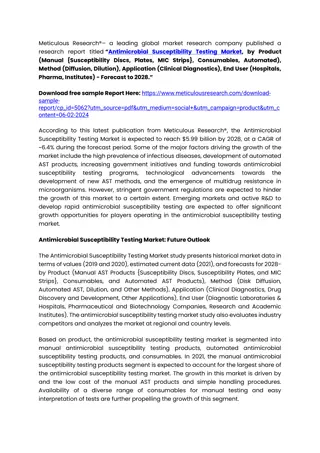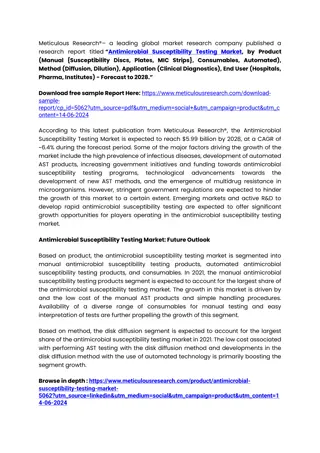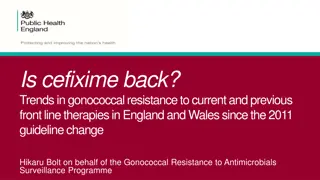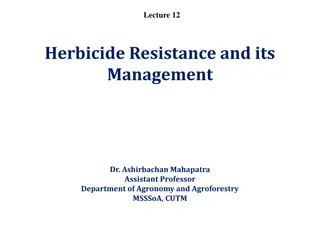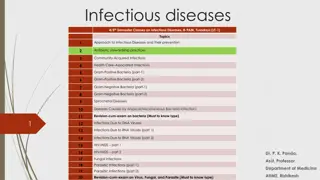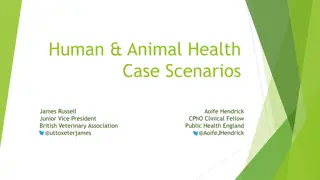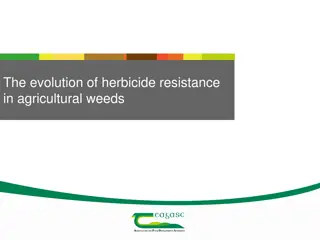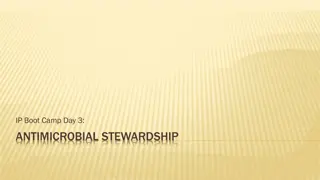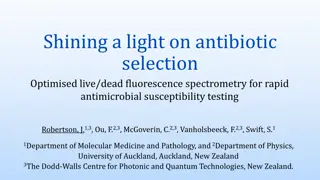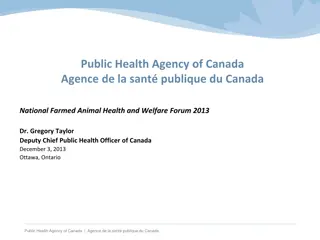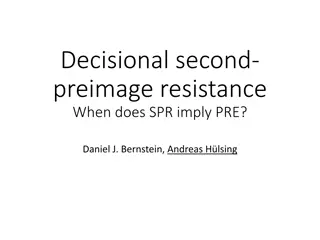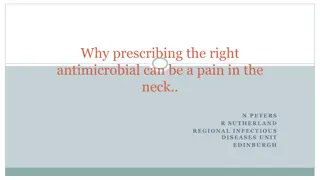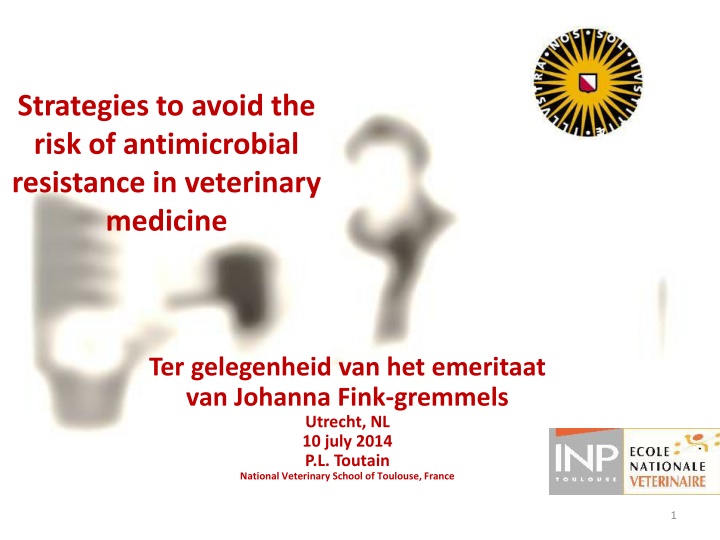
Strategies to Avoid Antimicrobial Resistance in Veterinary Medicine
Learn about the strategies to prevent antimicrobial resistance in veterinary medicine, including the importance of targeting specific pathogens, understanding zoonotic risks, and considering drug efficacy in animals and humans. Explore critical veterinary ecosystems and the global ecological implications of resistance emergence.
Download Presentation

Please find below an Image/Link to download the presentation.
The content on the website is provided AS IS for your information and personal use only. It may not be sold, licensed, or shared on other websites without obtaining consent from the author. If you encounter any issues during the download, it is possible that the publisher has removed the file from their server.
You are allowed to download the files provided on this website for personal or commercial use, subject to the condition that they are used lawfully. All files are the property of their respective owners.
The content on the website is provided AS IS for your information and personal use only. It may not be sold, licensed, or shared on other websites without obtaining consent from the author.
E N D
Presentation Transcript
https://encrypted-tbn2.gstatic.com/images?q=tbn:ANd9GcTmzWHk39ieWlPN_76UxOV4tscmdtVNVanQzB6xzu89MF9oe0Qfhttps://encrypted-tbn2.gstatic.com/images?q=tbn:ANd9GcTmzWHk39ieWlPN_76UxOV4tscmdtVNVanQzB6xzu89MF9oe0Qf Strategies to avoid the risk of antimicrobial resistance in veterinary medicine Ter gelegenheid van het emeritaat van Johanna Fink-gremmels Utrecht, NL 10 july 2014 P.L. Toutain National Veterinary School of Toulouse, France 1
The priorities of a sustainable veterinary antimicrobial therapy is related to public health issues, not to animal health issues
Strategies to avoid the risk of antimicrobial resistance in veterinary medicine: Q1: But of what resistance are we speaking?
We have to prevent emergence of resistance: but of what resistance? Target pathogens Target pathogens Target pathogens Zoonotics Zoonotics Zoonotics Commensal flora Commensal flora Commensal flora Resistance gene reservoir Global ecological Global ecological Resistance gene reservoir Global ecological problem problem problem Resistance gene reservoir Drug efficacy in animal: animal: Drug efficacy in Drug efficacy in animal: A vet issue A vet issue A vet issue Drug efficacy in efficacy in Drug efficacy in man man man Drug Possible overuse of antibiotics antibiotics antibiotics Possible overuse of overuse of Possible Natural eradication eradication eradication Natural Natural Risk for permanent colonisation colonisation colonisation Risk for permanent permanent Risk for Individual issue Individual issue Individual issue Population issue Population issue Population issue Animal issue Animal issue Animal issue Animal issue Animal issue Animal issue
Q2-For AR, what are the critical veterinary ecosystems in terms of public health (commensals)
The critical animal ecosystems in terms of emergence and spreading of resistance Open and large ecosystems Digestive tract Skin Open but small ecosystem Respiratory tract Closed and small ecosystem Mammary gland
Bacterial load exposed to antibiotics during a treatment Digestive tract Infected Lungs Test tube Manure waste 1 g Several tons 1 mg Several Kg Food chain Soil, plant .
Duration of exposure of bacteria exposed to antibiotics Infected Lungs tract tube Manure Sludge waste Digestive Test Few days Several weeks/months 24h Food chain Soil, plant .
Biophases & antimicrobial resistance G.I.T Proximal Distal AB: oral route Gut flora 1-F% Zoonotic (salmonella, campylobacter commensal ( enterococcus) Environmental exposure Food chain Blood Target biophase Bug of vet interest R sistance = public health concern R sistance = lack of efficacy
Biophases & antimicrobial resistance Gastrointestinal tract Proximal Distal Gut flora Intestinal secretion Bile Zoonotic (salmonella, campylobacter commensal ( enterococcus) Quinolones Macrolides Tetracyclines Food chain Systemic Administration Environment Blood Biophase Target pathogen R sistance =public health issue R sistance = lack of efficacy
Q3: What are the consequences of antibiotic elimination by the GIT on the gut flora
Genotypic evaluation of ampicillin resistance: copy of blaTEM genes per gram of feces 1 E+10 oral route fed 1 E+9 copies/g of feces 1 E+8 oral route fasted 1 E+7 intramuscular route 1 E+6 control group 1 E+5 1 E+4 0 1 2 3 4 5 6 7 days A significant effect of route of administration on blaTEM fecal elimination (p<0.001).
Q4: what about Persistence of Antibiotics in Manure, sludge, ..
Elimination of antibiotics into the environment As much as 75% of the antibiotics administered to food producing animals are directly excreted into the environment without any benefit for the animal
Rate of antibiotic degradation in manure, soil, waste Antibiotics matrix D gradation % Days Chlort tracycline Cattle manure 24 84 T tracycline Pig manure 50 48 Oxytetracycline Soil+contam manure 0 180 Oxytetracycline Sediment slurry , aeobiose 50 43 TMP Sewage sludge 50 22-41 Sulfamides Manure/sludge 0 28 Aminoglycosides manure 0 30 Tiamuline 50 26 Tylosine Pig manure, anaerobic 50 2 Bacitracin Sandy loam & manure 77 30 Enrofloxacin Cattle mannure <1 56
Ecological consequences of the commensal flora exposure by antibiotic AMR should be viewed as a global ecological problem with the animal and human commensal flora as the turntable of the system
Q5: what is the link between animals and man
The link animal/man The commensal genetic pool is large and encompasses the potential for many different mechanisms conferring AMR
Greening our AB One world, one health Commensal flora Genes of resistance (zoonotic pathogens) Environment Commensal flora Food chain
Action1: Reduction/suppression of antibiotic uses for prophylaxia
Terms to describe herd or flock antibiotic use Disease health Metaphylaxis (Control) Growth promotion Prophylaxis (pr vention) Therapy Risk factor present But no infection thus no antibiotics clinical disease Hazard present physiological performance. Banned
Action 2 Revision of dosage regimens for metaphylaxia (control)
Terms to describe herd or flock antibiotic use Disease health Metaphylaxis (Control) Growth promotion Prophylaxis (pr vention) Therapy Hazard present But Dosage regimen to be revised Risk factor present clinical disease physiological performance. Banned
MICs estimated with different inoculmum densities, relative to that MIC at 2x105 Linezolid Oxacillin Ciprofloxacin Daptomycin Gentamicin Vancomycin
The inoculum effect and Very Early Treatment (VET) Tested hypothesis Efficacious dosage regimen is different when the pathogen load is large, low or null Treatment should start as early as possible
Metaphylaxis vs. curative Pulmonary infectious model by inhalation (P multocida) Marbofloxaxine, Amoxicillin & et cefquinome Treatment during the prepatent (incubation) period (24h) vs. when symptoms are present M V. Vasseur, A A. Ferran, M Z. Lacroix, PL Toutain and A Bousquet-M lou, 27
Effect of amoxicillin (clinical cure ) metaphylaxis vs. curative Dose mg/kg 28
Effect of cefquinome (clinical cure ) metaphylaxis vs. curative Dose mg/kg 29
Effect marbofloxacin (clinical cure ) metaphylaxis vs. curative Marbofloxacin administrations early late Pourcentages of mice alive 100 % 80 60 40 20 0 1 mg/kg 40 mg/kg control Marbofloxacin doses
PCR in lung tissues samples (110h after an experimental lung infection P haemolytica) 7.00 Early +12h 6.00 Late +24-36h (log10/100mg) 5.00 ADN copy 4.00 3.00 2.00 1.00 0.00 2mg/kg 2mg/kg control E2 L2 L10 10mg/kg Detection of M. h DNA in lung tissues (PCR Tavqvet M.h., Vetlife, Fisher) DNA of M. haemolytica in calves of Control group Elimination of bacteria in 5/6 calves in E2 group Various and moderate titers in L2 and L10 group
An early/low dose treatment is better for both bacteriological cure, clinical cure and emergence of resistance than a late/high dose for three antibiotics: marbofloxacin, amoxicillin & cefquinome
In the target species, when to start a treatment?
Fever Alert: Fever Alert: intraruminal transponders, eye transponders, eye temperature, temperature, locomotor locomotor activity ., . fever tags, fever tags, intraruminal activity ., .
Action 3: The rudent use of currently used antibiotic is not enough and we need new green antibiotics i.e. antibiotics without impact on the gut flora
We need new antibiotic eco-friendly with less implications for human health These new antibiotics should be developed in respect for public health ecologic concerns. They should not influence the gut flora so to avoid the contamination of the environment with resistant bacteria. This implies to develop antibiotics having a good selectivity for for parenteral and oral use.
Selectivity of antimicrobial drugs in veterinary medicine Selectivity PD PK Selective distribution of the AB to its biophase Narrow spectrum
Innovation: PK selectivity of antibiotics Proximal Distal Gut flora Oral Zoonotic (salmonella, campylobacter commensal ( enterococcus) Efflux Food chain Quinolones, macrolides environment Blood IM Kidney Biophase R sistance = public health concern Animal health - 38
My view of an ideal antibiotic for vet medicine High plasma clearance Rapidly metabolized (in vivo, environment) to inactive metabolite(s) Elimination by non-GIT route (not bile or enterocyte efflux) Pathogens are extracellular; half-life rather short; not too short to compensate a relatively high clearance To avoid to expose distal GIT to active AB High renal clearance volume of distribution not too high High bioavailability by oral route Low binding to plasma protein Only free antibiotic is active; to reduce the possible nominal dosage regimen and environmental load High binding to cellulosis To inactivate AB in large GIT Likely a Low potency To avoid the most lipophilic AB that are excreted in the GIT High PK selectivity (biophase) To distribute only to target biophase 39
Renal clearance of different quinolones (all quinolones are not equals) Drugs Ofloxacin Levofloxacin Ciprofloxacin Sparfloxacin Grepafloxacin Trovafloxacin % of total clearance 70 65 50 13 10 5-10 Hooper DC CID 2000;30:243-254
Is there a successful antibiotic development complying with Eco- Evo concept?
New Eco-Evo drugs and strategies should be considered in vet medicine
Telavancin (Telavancin is a semi-synthetic derivative of vancomycin) is a new agent (FDA approcval 2009) for the treatment of Gram- positive It is excreted primarily by renal elimination, with 60 70% of the dose excreted unchanged in the urine and <1% in the faeces. No faecal concentration of telavancin was found, which probably explains the lack of an effect on the intestinal microflora Based on the microbiological data on the intestinal microflora as well as the results of the bioassays for antibiotic concentrations in faecal samples, telavancin has a favourable ecological profile.
Bottleneck for discovery of new AB in veterinary medicine 1980-1990 Human Health target amenable to Animal Health use HH: 2000 Remaining HH projects targeting resistant pathogen with unique market AH: Present Eco-evo drugs are needed AH will be on their own to develop green ATB
Discovery of new veterinary antibiotics need appropriate incentives
Action 4: Degradation or inactivation of AB and gene of resistance in the environment
Hazard associated to the release of antibiotic in the environment
Conclusions Appropriate use of antibiotics should not only include knowledge of the pathogen and its susceptibility, but also the spectrum and pharmacokinetic properties of the respective antimicrobial drug.

